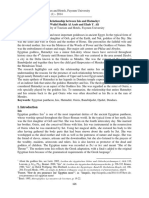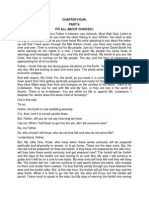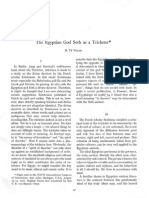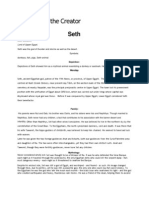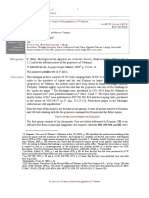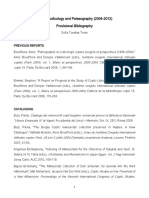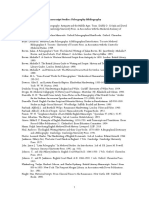Duat
Duat
Uploaded by
Nabil RoufailCopyright:
Available Formats
Duat
Duat
Uploaded by
Nabil RoufailOriginal Description:
Copyright
Available Formats
Share this document
Did you find this document useful?
Is this content inappropriate?
Copyright:
Available Formats
Duat
Duat
Uploaded by
Nabil RoufailCopyright:
Available Formats
Duat
1
Duat
This article is about the Egyptian underworld. For the evergreen tree, see Jambul. For the aviation weather service,
see DUATS.
A section of the Egyptian Book of the Dead
written on papyrus showing the Weighing of the
Heart in Duat where Anubis can be seen on the
far right, the scales are shown with the feather
balance, and Ammit awaits hearts that she must
devour the presence of Osiris at the gateway to
the paradise of Aaru dates the papyrus to a late
tradition of the myth.
Part of a series on
Ancient
Egyptian
religion
Ancient Egypt portal
v
t
e
[1]
In Egyptian mythology, Duat (pronounced "do-aht") (also Tuat and Tuaut or Akert, Amenthes, Amenti, or
Neter-khertet) is the realm of the dead. The Duat is the realm of the god Osiris and the residence of other gods and
supernatural beings. It is the region through which the sun god Ra travels from west to east during the night, and
where he battled Apep. It also was the place where people's souls went after death for judgement, though that was
not the full extent of the afterlife.
[2]
Burial chambers formed touching-points between the mundane world and the
Duat, and spirits could use tombs to travel back and forth from the Duat.
[3]
What we know of the Duat principally derives from funerary texts such as Book of Gates, Book of Caverns, Coffin
Texts, Amduat and the Book of the Dead. Each of these documents fulfills a different purpose and gives a different
perspective on the Duat, and different texts can be inconsistent with one another. The texts which survive differ in
age and origin, and it is likely that there was never a single uniform interpretation of the Duat.
[4]
Duat
2
The geography of Duat is similar in outline to the world the Egyptians knew. There are realistic features like rivers,
islands, fields, lakes, mounds and caverns, along with fantastic lakes of fire, walls of iron and trees of turquoise. In
the Book of Two Ways, one of the Coffin Texts, there is even a map-like image of the Duat.
[5]
The Book of the Dead and Coffin Texts were intended to guide people who had recently died through the Duat's
dangerous landscape and to a life as an akh or blessed spirit amongst the gods. The dead person must pass a series of
gates guarded by dangerous spirits, depicted as human bodies with grotesque heads of animals, insects, torches or
knives.
[6]
These beings have equally grotesque names, for instance "Blood-drinker who comes from the
Slaughterhouse" or "One who eats the excrement of his hindquarters".
[7]
Other features emphasised in these texts are
mounds and caverns, inhabited by gods or supernatural animals, which threatened the spirits of the dead. The
purpose of the books is not to lay out a geography, but to describe a succession of rites of passage which the dead
would have to pass to reach the afterlife.
[8]
If the deceased successfully passed these unpleasant demons, he or she would reach the Weighing of the Heart. In
this ritual, the heart of the deceased was weighed by Anubis, using a feather, representing Ma'at, the goddess of truth
and justice. The heart would become out of balance because of failure to follow Ma'at and any hearts heavier or
lighter than her feather were rejected and eaten by the Ammit, the Devourer of Souls. Those souls that passed the test
would be allowed to travel toward the paradise of Aaru.
In spite of the unpleasant inhabitants of the Duat, this was no Hell to which souls were condemned; the nature of
Duat is more complex than that. The grotesque spirits of the underworld were not evil, but under the control of the
Gods.
[9]
The Duat was also a residence of gods themselves; as well as Osiris, Anubis, Thoth, Horus, Hathor and
Ma'at all appear as a dead soul makes its way toward judgement. It was also in the underworld that the sun, Ra,
travelled under the Earth from west to east and was transformed from its aged Atum form into Khepri, the new
dawning Sun. Just as a dead person faced many challenges in the Duat, Ra faced attack in the underworld from the
evil serpent Apep.
[10]
References
[1] http:/ / en. wikipedia. org/ w/ index. php?title=Template:Ancient_Egyptian_religion& action=edit
[2] [2] Faulkner, p. 143
[3] Pinch, pp. 335
[4] [4] Taylor, p. 134
[5] [5] Taylor, p. 133
[6] Taylor, pp. 137
[7] [7] Pinch, p. 34
[8] Taylor, pp. 138140
[9] [9] Pinch, p. 34
[10] [10] Faulkner, p. 150
Bibliography
Faulkner, R. (translator): "The Egyptian Book of the Dead: The Book of Going Forth by Day". Chronicle Books,
2000
Pinch, G.: "Magic in Ancient Egypt". British Museum Press, 1994
Taylor, John (editor): "Ancient Egyptian Book of the Dead". British Museum Press, 2010.
External links
Wikimedia Commons has media related to Duat.
Egypt Legends Apophis in the Duat (http:/ / www. legends. egyptholiday. com/ apophis_duat. htm)
Article Sources and Contributors
3
Article Sources and Contributors
Duat Source: http://en.wikipedia.org/w/index.php?oldid=612652876 Contributors: -Ril-, 83d40m, 999, A. Parrot, Apepch7, AvicAWB, Bbarto, Berenike48, BrokenSegue, Bryan Derksen,
CaptainJae, CheeseDreams, Cronos, Davidstrauss, Dmthoth, Dmytro, Drift chambers, Editor2020, Epicgenius, Gee-Unit65, Ghirlandajo, Gospodar svemira, GraemeLeggett, Grm wnr, Hairy
Dude, HiEv, JMCC1, Jeff Dahl, Jilibi, John Price, Jonathan Tweet, LeCire, Loremaster, MZMcBride, Magioladitis, Michael Hardy, Midnightblueowl, Mmcannis, Morgan Leigh, MrArifnajafov,
NuclearWarfare, Patar knight, Pearle, Powerpackedpunch, RandomCritic, Sburke, Serasuna, SimonP, Special-T, Synergy, TShilo12, TUF-KAT, Tabauamunet, That Guy, From That Show!, The
Blade of the Northern Lights, The Haunted Angel, The Land, The Singing Badger, The Stick Man, Thursiya, Urco, Vatrena ptica, VolatileChemical, Zerida, 52 anonymous edits
Image Sources, Licenses and Contributors
Image:Egypt.Papyrus.01.jpg Source: http://en.wikipedia.org/w/index.php?title=File:Egypt.Papyrus.01.jpg License: Creative Commons Attribution-ShareAlike 1.0 Generic Contributors:
G.dallorto, Hajor, Ilse@, JLCA, JMCC1, Kajk, Luna92, Skeezix1000, Wikiborg4711, 1 anonymous edits
File:Eye of Horus bw.svg Source: http://en.wikipedia.org/w/index.php?title=File:Eye_of_Horus_bw.svg License: Creative Commons Attribution-Share Alike Contributors: Jeff Dahl
File:Pyramide Kheops.JPG Source: http://en.wikipedia.org/w/index.php?title=File:Pyramide_Kheops.JPG License: Creative Commons Attribution-ShareAlike 3.0 Unported Contributors:
Aoineko, Bradipus, Dirk Hnniger, Hajor, Olivier, 3 anonymous edits
Image:Commons-logo.svg Source: http://en.wikipedia.org/w/index.php?title=File:Commons-logo.svg License: logo Contributors: Anomie
License
Creative Commons Attribution-Share Alike 3.0
//creativecommons.org/licenses/by-sa/3.0/
You might also like
- Platinum DragonsDocument9 pagesPlatinum DragonsJairo Ferreira100% (1)
- Coptic Wedding CeremonyDocument26 pagesCoptic Wedding CeremonyNabil RoufailNo ratings yet
- Coptic Wedding CeremonyDocument26 pagesCoptic Wedding CeremonyNabil RoufailNo ratings yet
- UCLA Encyclopedia of Egyptology: TitleDocument9 pagesUCLA Encyclopedia of Egyptology: TitleMicho MakeenNo ratings yet
- Egyptian Book of GatesDocument130 pagesEgyptian Book of GatesJon Perry100% (1)
- Aspects of Colour in Ancient EgyptDocument16 pagesAspects of Colour in Ancient EgyptNabil RoufailNo ratings yet
- Uraeus: From Wikipedia, The Free EncyclopediaDocument6 pagesUraeus: From Wikipedia, The Free Encyclopediaelgorrion98No ratings yet
- Het Heru DanceDocument2 pagesHet Heru DanceAankh BenuNo ratings yet
- Dua of Imam Husain For Arafah DayDocument100 pagesDua of Imam Husain For Arafah DayTurkish BoyNo ratings yet
- Egyptian Amduat, The Miracle of Buto, and The Fluid of LifeDocument9 pagesEgyptian Amduat, The Miracle of Buto, and The Fluid of LifeDazzlestar100% (1)
- Ancient Egyptian Gods and GoddessesDocument3 pagesAncient Egyptian Gods and GoddessesNabil RoufailNo ratings yet
- Massiera, The So Called Statue of NehebkauDocument9 pagesMassiera, The So Called Statue of Nehebkauousermontou-1No ratings yet
- TefnutDocument4 pagesTefnutNabil Roufail100% (1)
- Maat & IsftDocument4 pagesMaat & IsftNosoNo ratings yet
- Instuctions of Ptah HoptepDocument10 pagesInstuctions of Ptah HoptepWalid Hesham GhareebNo ratings yet
- African Monotheism in Atenism PDFDocument17 pagesAfrican Monotheism in Atenism PDFSuzy SulimanNo ratings yet
- The Descent of Inanna To The Netherworld (English Translation)Document9 pagesThe Descent of Inanna To The Netherworld (English Translation)Spameron DiazNo ratings yet
- Priskin Coffin Texts Spell 155 On The MoonDocument39 pagesPriskin Coffin Texts Spell 155 On The Moonsychev_dmitry100% (2)
- The Journal of Egyptological Studies IV 2015Document38 pagesThe Journal of Egyptological Studies IV 2015khaledgamelyanNo ratings yet
- Nsia Mother of Nyankopon Naunet Mother of RaDocument5 pagesNsia Mother of Nyankopon Naunet Mother of RaArnionSosaNo ratings yet
- Chaos in Ancient Egypt GM 257 2019 25-36 PDFDocument12 pagesChaos in Ancient Egypt GM 257 2019 25-36 PDFsoha elmahdyNo ratings yet
- Bona Abakhulu Base KhemuDocument21 pagesBona Abakhulu Base Khemublackyakub144No ratings yet
- NebthetDocument6 pagesNebthetHelena LopesNo ratings yet
- 42 Confessions For MaAtDocument12 pages42 Confessions For MaAtbook1manNo ratings yet
- KhepriDocument3 pagesKhepriJake LindyNo ratings yet
- 303 Egyptian GodsDocument11 pages303 Egyptian Godsnightowl345No ratings yet
- Sirius in Art and Astronomy of DogonDocument7 pagesSirius in Art and Astronomy of DogonKonstantinos MantasNo ratings yet
- Granqvist & Inyama - Power and Powerlessness of Women in West African OralityDocument139 pagesGranqvist & Inyama - Power and Powerlessness of Women in West African Oralitysector4bk100% (1)
- Hottentot FablesDocument166 pagesHottentot FableselizabetetenorioNo ratings yet
- Docslide - Us - Goddesses and Gods of The Ancient EgyptiansDocument223 pagesDocslide - Us - Goddesses and Gods of The Ancient EgyptiansDaniel Salinas SotoNo ratings yet
- Coffin TextsDocument3 pagesCoffin TextsNabil RoufailNo ratings yet
- InfoDocument20 pagesInfoS GrayNo ratings yet
- Neter The Egyptian Word For God PDFDocument13 pagesNeter The Egyptian Word For God PDFDorianNo ratings yet
- Hathor (: Pyramid TextsDocument2 pagesHathor (: Pyramid TextsRegie Rey Agustin100% (1)
- Lesly Smith Kahun PapyrusDocument3 pagesLesly Smith Kahun PapyrusEunbit YiNo ratings yet
- Civil Enlil NinlilDocument25 pagesCivil Enlil NinlileannatumNo ratings yet
- Relationship Between Isis and HatmehytDocument11 pagesRelationship Between Isis and HatmehytAmal MohamedNo ratings yet
- Ascension Myth in The Pyramid TextsDocument20 pagesAscension Myth in The Pyramid Textsazai nabihNo ratings yet
- Pyramid TextsDocument28 pagesPyramid TextsMahmoud KamelNo ratings yet
- Naqada CultureDocument3 pagesNaqada CultureNabil Roufail100% (1)
- The Pig Cult in Ancient EgyptDocument18 pagesThe Pig Cult in Ancient EgyptLamis Mohamed100% (1)
- The Akan Website ArticlesDocument3 pagesThe Akan Website ArticlesJ. LeonNo ratings yet
- Mushroom Ceremony of The Mazatec Indians of MexicoDocument3 pagesMushroom Ceremony of The Mazatec Indians of Mexicojosemaria vazquezNo ratings yet
- The Inanna and Dumuzi CycleDocument11 pagesThe Inanna and Dumuzi CycleV.F.No ratings yet
- Bwt:Taboo in Ancient KemetDocument25 pagesBwt:Taboo in Ancient KemetAankh BenuNo ratings yet
- The Egyptian God Seth As A TricksterDocument5 pagesThe Egyptian God Seth As A TricksterBlackspiderjunk100% (2)
- Its All About Choices!Document7 pagesIts All About Choices!Ezra AdamNo ratings yet
- Tree NTRWT in Ancient KMTDocument19 pagesTree NTRWT in Ancient KMTAankh Benu100% (2)
- TefnutDocument5 pagesTefnutRaven SynthxNo ratings yet
- Hymn To ShulgiDocument3 pagesHymn To ShulgiNCC1401No ratings yet
- Saturn, or Kronos, Was A Principal Deity in Greek and Roman Mythology. The Old Italic Saturn, WhoseDocument2 pagesSaturn, or Kronos, Was A Principal Deity in Greek and Roman Mythology. The Old Italic Saturn, WhoseChris JacksonNo ratings yet
- WWUE Roth Opening of The Mouth Ritual 2Document24 pagesWWUE Roth Opening of The Mouth Ritual 2Timothy Smith100% (1)
- PtahhotepDocument23 pagesPtahhotepIwenmutef Sa AsetNo ratings yet
- Lioness NyahbinghiDocument5 pagesLioness NyahbinghiPoqo Aviwe Bulalabathakathi TyumreNo ratings yet
- Using Definitions of Reality From African Deep Thinkers To Examine IdeasDocument39 pagesUsing Definitions of Reality From African Deep Thinkers To Examine IdeasBonotchi MontgomeryNo ratings yet
- CharwahaDocument27 pagesCharwahaSandeep ChauahnNo ratings yet
- TE VELDE - The Egyptian God Seth As A Trickster (1968) - OCRDocument4 pagesTE VELDE - The Egyptian God Seth As A Trickster (1968) - OCRDaniel Arpagaus100% (1)
- Precepts of Ptah-HotepDocument41 pagesPrecepts of Ptah-HotepZeljko Zed ZidaricNo ratings yet
- Guardian of The CreatorDocument43 pagesGuardian of The CreatorRaven SynthxNo ratings yet
- The Bremner-Rhind Papyrus IVDocument14 pagesThe Bremner-Rhind Papyrus IVЛукас МаноянNo ratings yet
- Kronion Son of Apion, Head of The Grapheion of TebtynisDocument7 pagesKronion Son of Apion, Head of The Grapheion of TebtynisNabil RoufailNo ratings yet
- Archive of Aurelius Ammon, Scholasticus, Son of Petearbeschinis 2Document13 pagesArchive of Aurelius Ammon, Scholasticus, Son of Petearbeschinis 2Nabil RoufailNo ratings yet
- Petitions From MagdolaDocument2 pagesPetitions From MagdolaNabil RoufailNo ratings yet
- Archive of Aurelius Ammon, Scholasticus, Son of PetearbeschinisDocument4 pagesArchive of Aurelius Ammon, Scholasticus, Son of PetearbeschinisNabil RoufailNo ratings yet
- Patron's DescendantsDocument9 pagesPatron's DescendantsNabil RoufailNo ratings yet
- The Demotic GraffitiDocument15 pagesThe Demotic GraffitiNabil Roufail0% (1)
- Hammamat Expedition: Commander's Record: Nederhof - EnglishDocument4 pagesHammamat Expedition: Commander's Record: Nederhof - EnglishNabil RoufailNo ratings yet
- The Transmission of Offices in The MiddDocument21 pagesThe Transmission of Offices in The MiddNabil RoufailNo ratings yet
- Hammamat Expedition: Official Record: Nederhof - EnglishDocument4 pagesHammamat Expedition: Official Record: Nederhof - EnglishNabil RoufailNo ratings yet
- Nubia Neglected HeritageDocument11 pagesNubia Neglected HeritageEster PalmaNo ratings yet
- Hammam at 191Document3 pagesHammam at 191Nabil RoufailNo ratings yet
- Coptic Codicology and PalaeographyDocument18 pagesCoptic Codicology and PalaeographyNabil RoufailNo ratings yet
- The Liber Institutionis Michaelis in Medieval NubiaDocument13 pagesThe Liber Institutionis Michaelis in Medieval NubiaNabil RoufailNo ratings yet
- The Library of The Monastery of Saint Shenute at AtripeDocument20 pagesThe Library of The Monastery of Saint Shenute at AtripeNabil RoufailNo ratings yet
- Palaeo GraphyDocument22 pagesPalaeo GraphyNabil RoufailNo ratings yet
- Paleography BibliographyDocument5 pagesPaleography BibliographyNabil RoufailNo ratings yet
- Palaeo GraphyDocument22 pagesPalaeo GraphyNabil RoufailNo ratings yet
- CopticDocument4 pagesCoptichermas67No ratings yet
- Coptic AlphabetDocument6 pagesCoptic AlphabetNabil RoufailNo ratings yet
- Simulacro Cassiel - MonsterDocument2 pagesSimulacro Cassiel - Monsterhenri.santos779No ratings yet
- resultatsPASS CN2023 2024Document26 pagesresultatsPASS CN2023 2024Abdelillah AdamiNo ratings yet
- History and Background of KoreaDocument7 pagesHistory and Background of KoreaLorry Angela SalvatierraNo ratings yet
- Catholic Whistleblowers April 1, 2018 Letter To U.S. BishopsDocument3 pagesCatholic Whistleblowers April 1, 2018 Letter To U.S. BishopsNational Catholic Reporter100% (2)
- Pa. Actionable Intelligence Briefing 022 18 Dec 09Document5 pagesPa. Actionable Intelligence Briefing 022 18 Dec 09scott blanchardNo ratings yet
- John 6:60-71Document5 pagesJohn 6:60-71John ShearhartNo ratings yet
- Maneater of Malgudi: Submitted To: Dr. Manoj Kumar Submitted By: Koysha Katiyar B.A. - (H) - ENGLISH/SEM 3Document7 pagesManeater of Malgudi: Submitted To: Dr. Manoj Kumar Submitted By: Koysha Katiyar B.A. - (H) - ENGLISH/SEM 3Koysha Katiyar100% (1)
- Class K.G. Syllabus & Date Sheet For FA-IIDocument1 pageClass K.G. Syllabus & Date Sheet For FA-IISayedAsgarAliNo ratings yet
- Timeline Bible QuizDocument5 pagesTimeline Bible QuizXavier HernandezNo ratings yet
- Guzik - Revelation 10Document5 pagesGuzik - Revelation 10JaszaNo ratings yet
- Hatsurei Ho MeditationDocument3 pagesHatsurei Ho MeditationDevlinPyxNo ratings yet
- Chennai Ramadan Calendar 2024 UrdupointDocument2 pagesChennai Ramadan Calendar 2024 UrdupointAbdul Samad ShaikNo ratings yet
- StoicismDocument3 pagesStoicismRegilon MujarNo ratings yet
- 2021 08 Cultures of ASEAN Countries CHAPTER 3Document25 pages2021 08 Cultures of ASEAN Countries CHAPTER 3Trứng Là EiNo ratings yet
- GuestsDocument4 pagesGuestsRose GeeNo ratings yet
- Vernacular Asia Conference Abstracts 2017 PDFDocument60 pagesVernacular Asia Conference Abstracts 2017 PDFanil ariNo ratings yet
- 4 Women Leaders in The New Testament 1 3Document20 pages4 Women Leaders in The New Testament 1 3Meagan MurphyNo ratings yet
- Anti Oedipus PapersDocument218 pagesAnti Oedipus PapersPieter-Jan Beyul100% (4)
- Migratory Movements and The Patterns of CaribbeanDocument19 pagesMigratory Movements and The Patterns of CaribbeanJensen100% (3)
- Mantra For EnlightenmentDocument1 pageMantra For EnlightenmentJeyashankar RamakrishnanNo ratings yet
- 3.1 Молитвы Калашу и ДипеDocument4 pages3.1 Молитвы Калашу и ДипеSudhiraDasNo ratings yet
- Courageous LeadershipDocument17 pagesCourageous LeadershipJesus Americo Lopez Lopez33% (3)
- HW Essay 3Document4 pagesHW Essay 3jkfiriorokgNo ratings yet
- Atharul Hadith NotesDocument7 pagesAtharul Hadith Notesd4gpqz7ts6No ratings yet
- Eli CohenDocument24 pagesEli CohenJimmy Leonard100% (1)
- Scripture Prayers For Physical Healing PDFDocument3 pagesScripture Prayers For Physical Healing PDFPrince Nornor-QuadziNo ratings yet
- Re-Gifting To The King: How Did The Wisemen Know To Seek Jesus?Document6 pagesRe-Gifting To The King: How Did The Wisemen Know To Seek Jesus?James BayucanNo ratings yet
- Meg1 Full NotesDocument79 pagesMeg1 Full Notesdaspom98fNo ratings yet




































